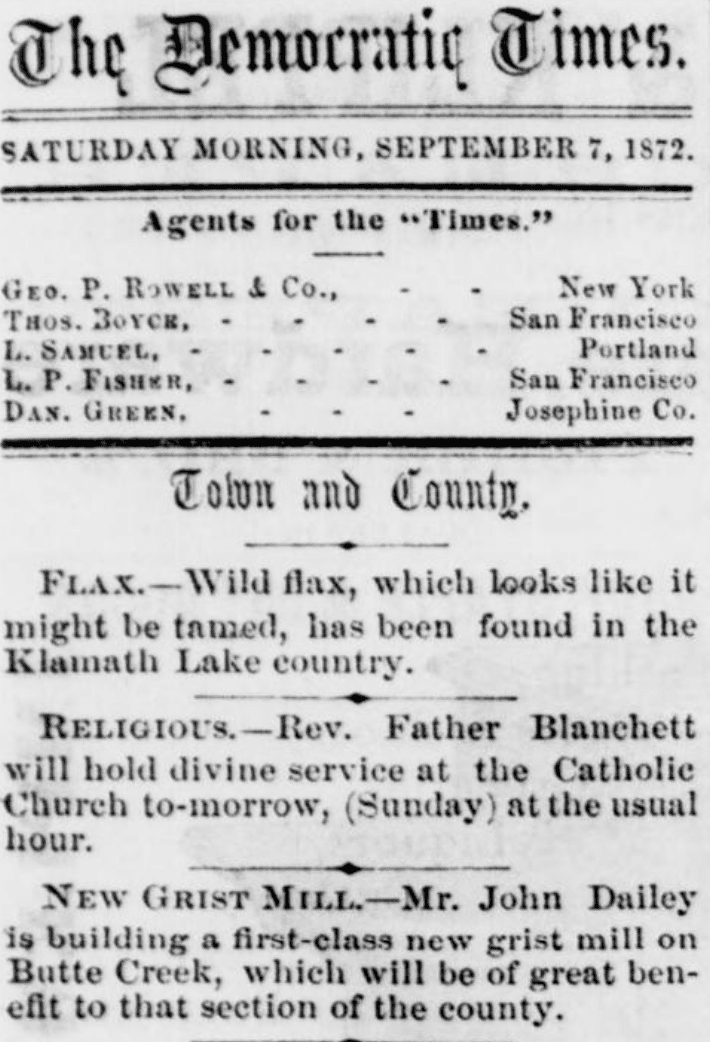Our History
Eagle Point was first settled by Pleasant W. Snow & Lavina Snow filed a Donation Land Claim.
Eagle Point, Oregon, established the year before, was abandoned due to Indian conflicts stemming from the Takelma and possibly the Shasta tribes of Native Americans in the Rogue River Wars of the 1850s, which ultimately saw most of the Native Americans either killed or forced onto Indian reservations.
Eber Emery (1819-1891) and his wife, Sophia Hoover Emery, arrived in Oregon in 1850–before Oregon had become a state. At the end of their pack train journey, Eber and Sophia established their home and, at the same time, established the area for a new community. Eber was a millwright and used his skills to build Ashland’s first mills: a flour mill in 1851 and a sawmill in 1851-52. He continued to develop the city of Ashland by building and operating the Ashland House hotel.
Eber Emery and John Daley purchased the land in what is now Eagle Point, along Little Butte Creek, for a flour mill site in February 1872.
Emery continued to reside in the area until his death in Gold Hill in 1891.

John Daley

Eber Emery
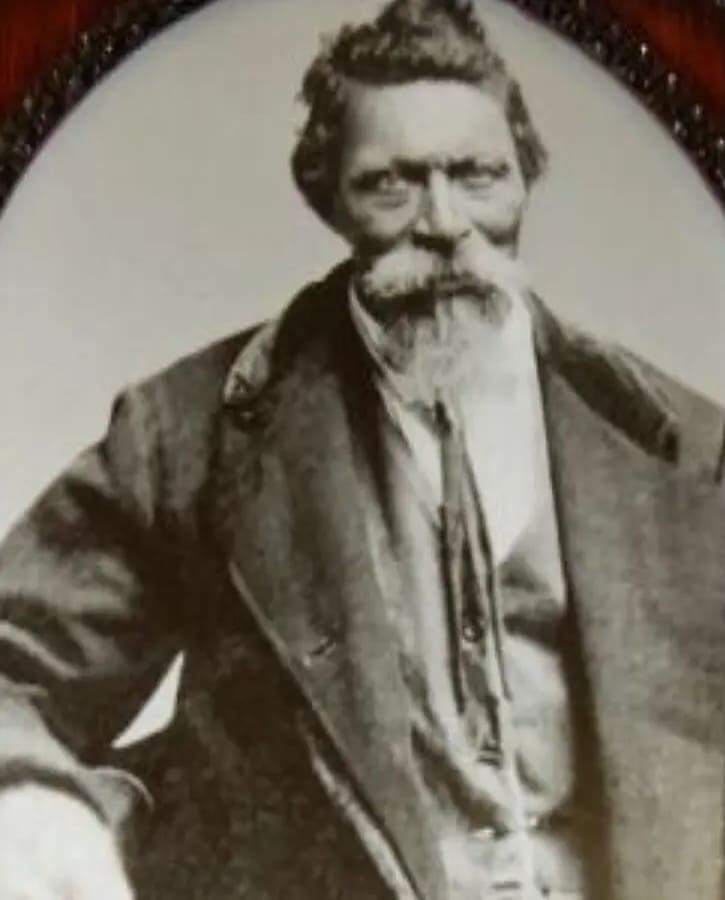
John Mathews, landowner
In March 1872, Daley and Emery purchased the right of way from a landowner, John Mathews, to cut a millrace that was nearly a half-mile long. The water from Little Butte Creek would be diverted into it and then into the lower level of the Mill to power the turbine.
In 1872, a post office was established, along with a hotel, several blacksmith shops, a general store, a merchandise store, and a warehouse.
In 1872, Adronirum John Daley chose a site on the west bank of Little Butte Creek, approximately 20 miles northeast of Jacksonville and 11 miles northeast of Medford. His father, John W. Daley, Sr. and Eber Emery began construction in July, 1872.
The building was situated on a fairly steep bank on the west side of the creek. An old irrigation ditch on the site was dug deeper by horse and hand labor.
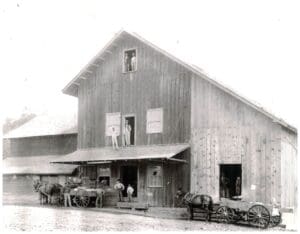 The lumber for the mill was milled from a pine stand located at Butte Falls. Utilizing traditional techniques of the era, they crafted the mill using hand-hewn lumber, employing mortise and tenon joints, and securing the structure with sturdy square 4-inch nails. Over the span of approximately eight months, the framework of the mill began to take shape, with the first floor standing proudly as a testament to their craftsmanship.
The lumber for the mill was milled from a pine stand located at Butte Falls. Utilizing traditional techniques of the era, they crafted the mill using hand-hewn lumber, employing mortise and tenon joints, and securing the structure with sturdy square 4-inch nails. Over the span of approximately eight months, the framework of the mill began to take shape, with the first floor standing proudly as a testament to their craftsmanship.
The original mill was a four-story structure with a daylight basement, the main floor with the grinding floor and shop area, and two upper floors probably used for storage. To the north of the mill building were four square storage bins for grain.
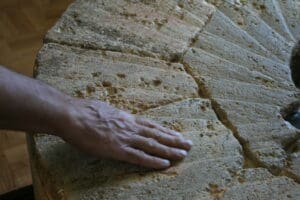 Emery and Daley’s attentions then turned to the installation of the millstones, weighing a substantial 1400 pounds each. These formidable stones were procured from France, meticulously assembled in Illinois, and embarked on an arduous journey. They traveled by ship down the Mississippi, circumnavigated Chile, and finally arrived at the coast of California. They were transported by ox cart to their final destination in Eagle Point.
Emery and Daley’s attentions then turned to the installation of the millstones, weighing a substantial 1400 pounds each. These formidable stones were procured from France, meticulously assembled in Illinois, and embarked on an arduous journey. They traveled by ship down the Mississippi, circumnavigated Chile, and finally arrived at the coast of California. They were transported by ox cart to their final destination in Eagle Point.
(An interesting story that has never been substantiated surrounds the shipment of the burr stones. Daley supposedly sent his two sons by wagon to bring the stones to Eagle Point from Crescent City. On the return trip, one of the sons was killed in an Indian attack.)
Following an additional ten months of diligent effort, the mill reached its culmination and proudly bore the moniker “Daley and Emery Butte Creek Mills.” On the memorable date of August 30, 1873, the first batch of wheat underwent the transformation into flour, marking the commencement of operations. Swiftly gaining momentum, within a mere few weeks, the mill churned out flour to meet the demands of its eager clientele, achieving an impressive output of up to 40 barrels per day.
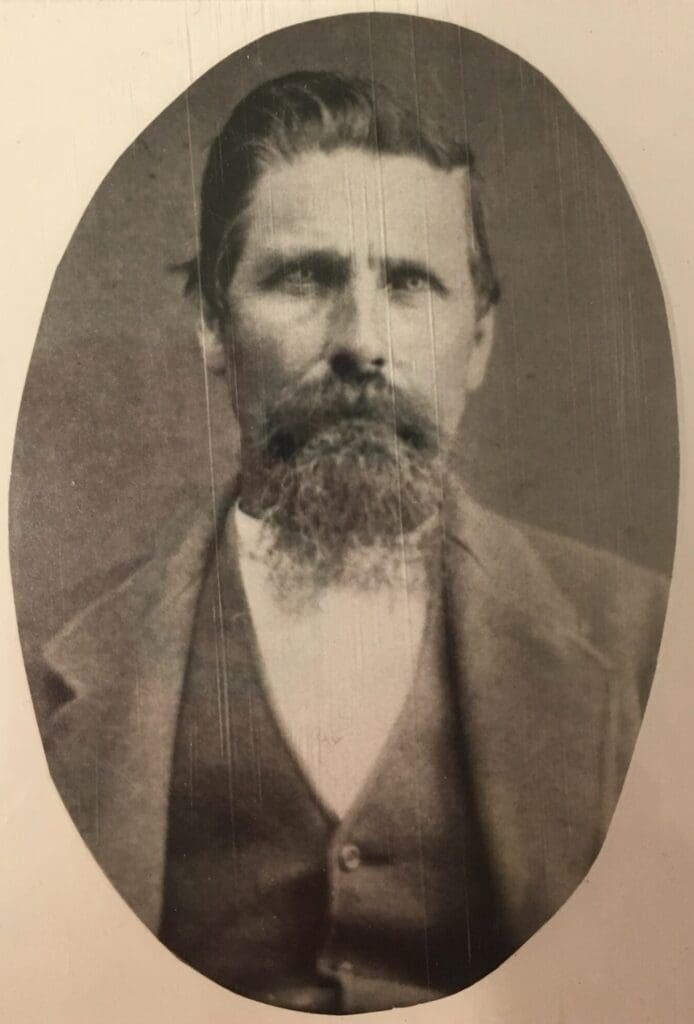
Adorniram (AJ) Daley
Opting to part ways in their mill partnership, Emery and Daley gracefully dissolved their collaboration. Stepping into the helm were Daley’s own kin, his son AJ and grandson George, who assumed control of the mill’s operations. With a new era dawning, they christened their endeavor the “Snowy Butte Mill,” signaling a fresh chapter in its storied history.
The Snowy Butte Mill

The landscape shifted with the entrance of competition, as a separate consortium of investors endeavored to establish a rival flour mill just down the road. Yet, as the Snowy Butte Mill underwent enhancements, notably with the substitution of its original millstones with advanced rollers, the competing investors swiftly discerned the futility of their challenge. Recognizing the superior efficiency and quality of the Snowy Butte Mill, they gracefully conceded defeat, relinquishing their pursuit. The original millstones and equipment, however, were kept in storage.
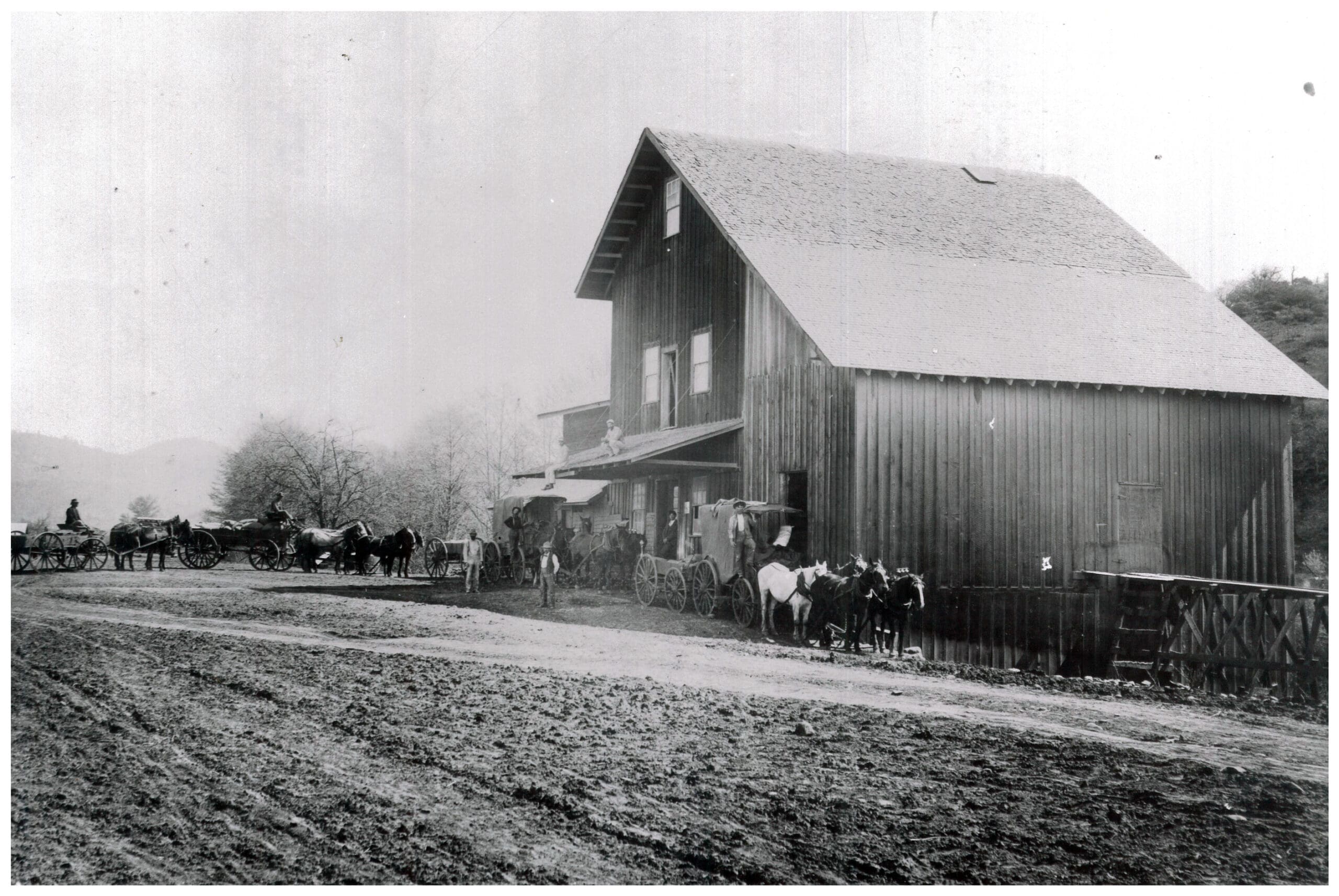
The addition was built around 1890 and is the current location of our Country Store.
AJ and George Daley orchestrated the sale of the mill to a select cadre of Jacksonville residents, ushering in a new era under the banner of the “Snowy Butte Roller Flouring Mill Company.” Despite the change in ownership, George remained steadfast in his dedication to the mill, ensuring continuity in its operations. During this period, the mill’s productivity soared, reaching a remarkable output of up to 50 barrels per day, with the added convenience of packaging for shipment facilitated by the burgeoning railroad network.
The reins of the mill transitioned once more, now falling into the capable hands of William Holmes, alongside two of his brothers, joined by the astute addition of Harry Carlton. This new consortium, rooted in the group of Jacksonville residents, assumed stewardship of the enterprise, poised to steer it through the currents of progress and prosperity.
A Winning Product!
The mill won a “First Premium” designation for its flour at the Oregon Industrial Exposition. See an advertisement for the Exposition here.

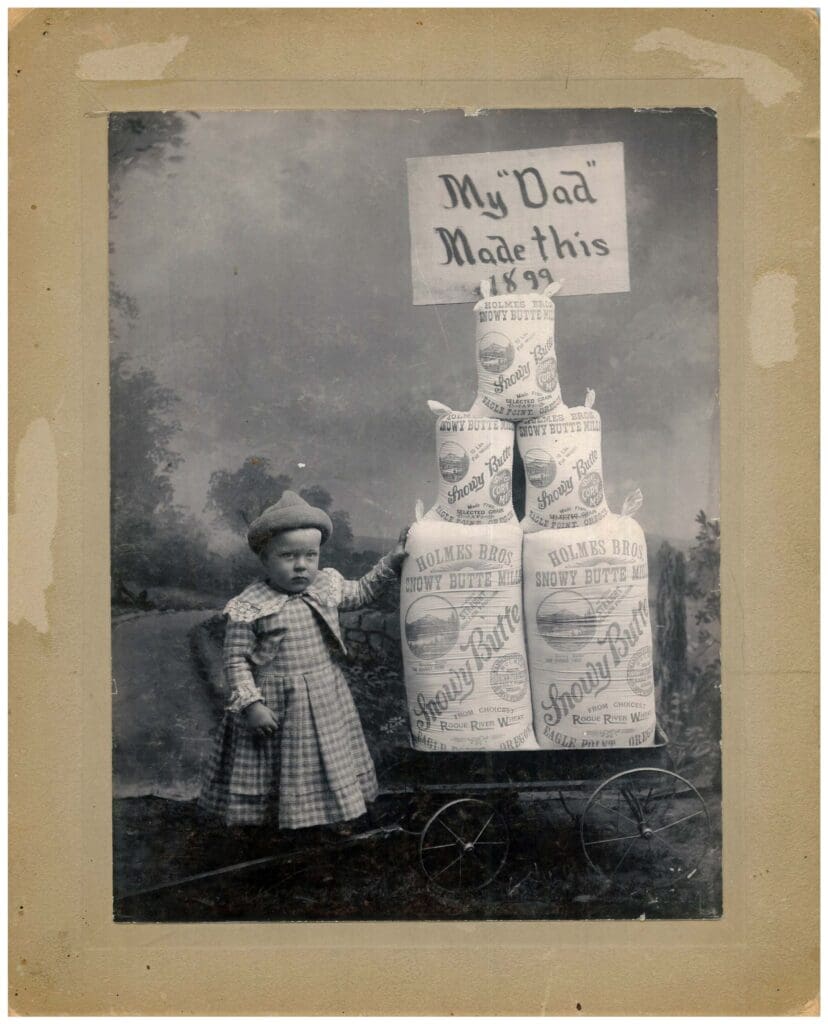
George Bearl Daley poses with bags of Snowy Butte Flour
Now that the Pacific and Eastern Railroad connected Eagle Point to the rest of the world, the commercial district began to thrive. The city became incorporated in 1911. In these early days, Eagle Point comprised three hotels, a livery stable, a blacksmith shop, a few saloons, dance halls, the mill, and a handful of businesses: a bank, a confectionary store, and a general store.
In 1912, an addition was built on the south side to provide for additional storage space and a loading dock area. Columns with chamfering similar to the original second floor are used on the first floor. The roof is extended at the same pitch. The framing uses 2″ x 8″ studs and 2″ x 6″ rafters. The siding is about the same size but is cut with a circular saw rather than whip-sawn as on the original section of the mill. Large posts are used in the basement, but the joints are nailed rather than pegged.
The mill found new ownership in the capable hands of FS Brandon and GW Brandon, brothers with a vision for expansion and innovation. Under their guidance, the mill completed a transformative upgrade, incorporating state-of-the-art equipment to steam and roll barley and oats, thereby broadening its capabilities and enhancing its offerings to meet the evolving demands of the market.
The Brandons demonstrated unwavering dedication to the noble cause of the World War I efforts. According to the Medford Mail’s account, the mill operated at peak efficiency, operating at full capacity to fulfill a crucial government contract for a staggering 70,000 barrels of flour, thereby contributing significantly to the war effort through their industrious endeavors.
The Snowy Butte Mill closed, and ownership of the property shifted to the Eagle Point Bank, marking the onset of a prolonged period of dormancy. For a span of twelve years, the once-bustling mill lay dormant, its machinery silent, awaiting a new chapter in its storied history.
Under the decisive leadership of Mrs. Campbell, President of the Eagle Point Bank, a pivotal decision was made to breathe new life into the dormant mill. Entrusting the task to the capable hands of George Putman, a spirited entrepreneur new to the region, marked a turning point in the mill’s fate. Together with his sons, Ed and Frank, George embarked on a meticulous restoration effort, swiftly returning the mill to its former operational glory. Impressed by the Putmans’ dedication and expertise, Mrs. Campbell facilitated the transition of ownership, selling the mill along with an adjoining parcel of land to the Putman family. Thus, heralding the dawn of a new era, the location was reimagined and operated under the banner of “Putman Bros. Feed and Seed,” perpetuating its legacy with renewed vigor and purpose.
An addition was added to the north during the 1930s for frozen food lockers and a meat cutting and packing area. Customers could now bring their slaughtered animals in for butchering, packaging, and processing. Construction in this section is similar to the earlier addition. Both the 1912 and 1930s additions are compatible with the original building character using similar type materials and detailing. They provide necessary added space for the Mill, but also maintain the original architectural integrity.
With a keen sense of tradition and a vision for authenticity, George Putman embarked on a transformative endeavor within the mill’s confines. Striving to honor its heritage, he dismantled the modern roller units, reverting the mill to its original state as a grist mill adorned with the timeless allure of millstones. This restoration not only breathed new life into the structure but also reinstated its pivotal role in the local community.
Expanding upon this foundation, George tirelessly developed the property, shaping it into a multifaceted hub of agricultural commerce and service. Under the banner of “Putman Bros. Feed and Lockers,” the establishment evolved to encompass not only the grist mill but also a comprehensive array of offerings.
Here, patrons found a wealth of provisions, ranging from freshly ground flour to essential farming implements, horse medicine, veterinary supplies, animal feed, and garden resources. Moreover, the addition of a butcher shop provided a convenient solution for livestock owners, offering services for the cutting, wrapping, and processing of their slaughtered animals, thereby fostering a symbiotic relationship between the community and the establishment.
Tragically, the Putman family faced a profound loss with the untimely passing of both Ed Putman and his father, George Putman, within a span of mere months. This unexpected turn of events left Frank Putman to shoulder the responsibility of managing and operating both the cherished Mill and Feed Store, navigating the challenges of this new reality with resilience and determination.
The torch of stewardship passed from the Putman family to Peter and Cora Crandall, who embraced the challenge of preserving the mill’s heritage as a water-powered flour mill with unwavering dedication. Drawing upon Peter’s engineering prowess and Cora’s adept management and baking skills, they formed a formidable partnership, poised to steer the mill toward continued success.
Under their attentive care, the feed store underwent a transformation into a quaint country store, brimming with an array of baking mixes and meticulously packaged fresh-ground flour, alongside other delectable baking essentials.
This evolution reflected their commitment to providing patrons with high-quality products while honoring the mill’s rich culinary traditions. With a nod to its iconic location, Peter and Cora bestowed upon the establishment the official moniker of Butte Creek Mill, signaling a new chapter in its illustrious history under their capable stewardship.

The Crandall family made the feed and animal supply area into the Country Store as we know it today. The mill was now named the Butte Creek Mill.
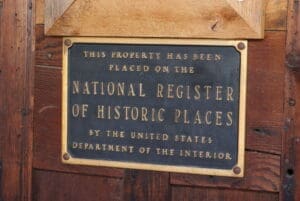 The Butte Creek Mill (Oregon SP Snowy Butte Flour Mill) was placed on the National Register of Historic Places on September 1, 1976, a testament to its enduring significance in the annals of American heritage. If you’re interested, check out the original application.
The Butte Creek Mill (Oregon SP Snowy Butte Flour Mill) was placed on the National Register of Historic Places on September 1, 1976, a testament to its enduring significance in the annals of American heritage. If you’re interested, check out the original application.
Upholding a steadfast commitment to preserving its storied history, the Crandalls endeavored to cultivate a space for communal engagement and appreciation. Their dedication manifested through the provision of guided tours, inviting patrons to immerse themselves in the mill’s rich tapestry of tradition and craftsmanship. These tours not only offered insights into the mill’s fascinating past but also fostered a sense of community connection, drawing visitors into the heart of its timeless allure.
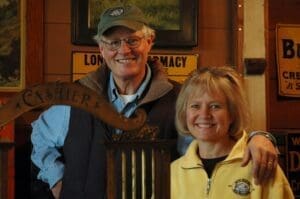
Bob and Debbie Russell
The Crandalls passed ownership to Bob and Debbie Russell, who embraced the cherished legacy of the mill with a fervent commitment to its preservation and the nurturing of community bonds. Building upon the Crandalls’ vision, they endeavored to instill a sense of reverence for the mill’s history while fostering an atmosphere of warmth and camaraderie. From enlightening tours showcasing the intricate mechanics of water power to the inception of vibrant community events, the Russells embodied the essence captured by the sign adorning their counter: “Enter as Strangers, Leave as Friends.”
A somber shadow fell upon the mill as tragedy unfolded. Initially, the loss of Debbie left the mill in the care of her grieving husband and daughter, a poignant reminder of life’s fragility.
 However, fate dealt another devastating blow when, on Christmas Day, a ferocious fire ravaged the mill, reducing it to ashes and embers. The community rallied with remarkable resilience and solidarity in the face of such adversity. Swiftly mobilizing, initiatives to rebuild the mill were set into motion, propelled by a collective determination to resurrect this beloved cornerstone of the community.
However, fate dealt another devastating blow when, on Christmas Day, a ferocious fire ravaged the mill, reducing it to ashes and embers. The community rallied with remarkable resilience and solidarity in the face of such adversity. Swiftly mobilizing, initiatives to rebuild the mill were set into motion, propelled by a collective determination to resurrect this beloved cornerstone of the community.
The Mill stones were not harmed in the fire, and the basement remained intact.
In response to the devastating loss, the Butte Creek Mill Foundation emerged, steadfast in its mission to resurrect the cherished landmark from the ashes. Bob Russell transferred the property to the Butte Creek Mill Foundation to enhance their ability to restore the mill.
The Butte Creek Mill Foundation officially was granted 501(c)(3) “public charity” status. See our recognition letter here.
With a clear vision and unwavering determination, the Foundation meticulously calculated the daunting costs of restoration, amounting to an estimated $2.5 million.
Yet, buoyed by an outpouring of support from the community, coupled with generous donations, spirited fundraisers, and invaluable grants, the Foundation achieved remarkable progress. Within a mere year and a half, they managed to amass an impressive sum of $1.7 million, a testament to the unwavering solidarity and collective determination of all those who rallied behind the cause.
Skilled millwrights hailing from Washington State embarked on a journey to Eagle Point, answering the call to breathe new life into the dormant milling equipment. With precision and expertise, they meticulously restored the intricate machinery, coaxing the millstones back to life to resume their vital task of milling wheat.
In a heartening display of unity, community volunteers joined forces with seasoned professionals, working hand in hand to revive the mill and usher in a new era of retail operations. Their combined efforts bore fruit as the doors of the Butte Creek Mill swung open once more, welcoming patrons back into its storied embrace.
Thanks to the unwavering dedication of all involved, the Butte Creek Mill reclaimed its rightful place as a beacon of community spirit and culinary tradition. Today, the cherished blends crafted by the Crandalls endure, delighting customers with a taste of history and heritage.
Trout Unlimited (TU) works to protect wild and native trout and salmon watershed, including the abundance of salmon and steelhead that habitat the Little Butte Creek. The organization worked collaboratively with Bob Russell and the Butte Creek Mill Foundation to determine the water flow required to keep the Mill operating and the amount of water needed to provide fish passage, ecosystem function, and water quality.
As a result of their research and collaboration, the team formalized an agreement to transfer a senior right in the watershed to TU. This agreement secures permanent water protections for Litte Butte Creek while also ensuring the Mill will be able to operate into the future by preventing users upstream from claiming or diverting the water flow.
This water rights transfer is the largest of its kind in Oregon’s history and exemplifies the Butte Creek Mill’s commitment and support of the local community, including the region’s native fish and river ecology.

